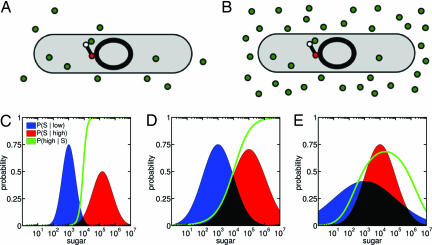Fig. 1.
A two-state classifier problem and its Bayesian solution, the posterior probability. A cell must infer from intracellular concentrations of a nutrient or signaling molecule (green circles) whether the molecule is in high or low concentrations in the extracellular environment. (A and B) Fluctuations in the environment and molecule detection and transport can lead to similar intracellular concentrations of the molecule for different extracellular conditions. The cellular decision-making machinery, shown as a simple genetic network, must decide from intracellular information the probable state of the extracellular environment. (C) Two distributions for intracellular numbers of a sugar molecule: the low sugar state is in blue, the high sugar state is in red. For an intracellular sugar level S, the green curve is the posterior (predicted) probability that the extracellular state is the high sugar state, P(high|S). (D) For two intracellular distributions that overlap substantially, the posterior probability for the high sugar state transitions gradually from low to high values. (E) The posterior probability, P(high|S), need not be monotonic. The low sugar state is more probable at both low and high intracellular sugar, and P(high|S) goes through a maximum.

